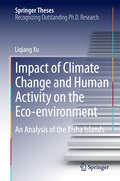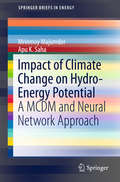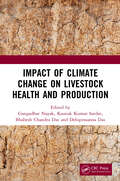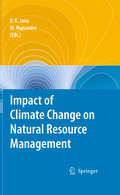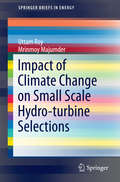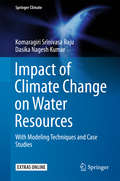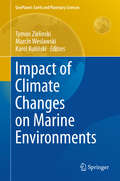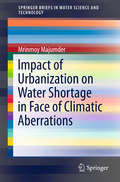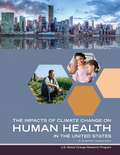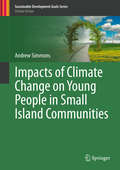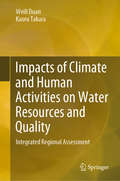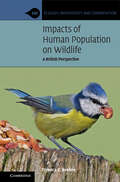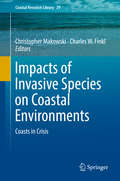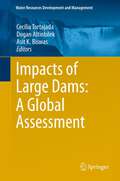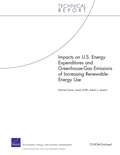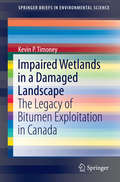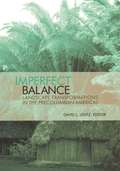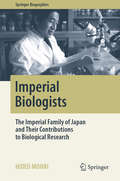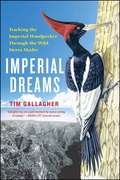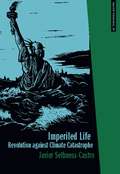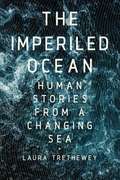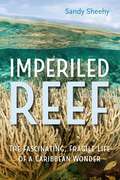- Table View
- List View
Impact of Climate Change and Human Activity on the Eco-environment
by Liqiang XuThis study describes the fundamentals of assessing the vulnerability of coral islands, as well as environmental management and resource exploitation. Using seabird subfossils, such as bones, guano, eggshells etc. , which have been well preserved on the Xisha Islands in the South China Sea, the author identifies the influences of climate change and human activity on seabird populations and diets. Understanding the past is of great importance for predicting the future, and seabird subfossils provide valuable information, which can be used to study changes in seabird ecology, paleoceanography and palaeoclimate. Furthermore, this study proposes examining the biogeochemical cycling of some elements present in the geosphere, hydrosphere, biosphere and atmosphere. Dr. Liqiang Xu works at the Hefei University of Technology, China.
Impact of Climate Change on Hydro-Energy Potential
by Mrinmoy Majumder Apu K. SahaThis Brief presents the impact of climatic abnormalities on hydropower potential of different regions of the World. In this regard, multi-criteria decision making and neural network are used to predict the impact of the change cognitively by an index. The results from the study show that the hydro-energy potential of the Asian region is mostly vulnerable with respect to other regions of the World. The model results also encourage further application of the index to analyse the impact of climate change on potential of hydro-energy.
Impact of Climate Change on Livestock Health and Production
by G D Nayak K K Sardar B C Das D P DasThis volume of 30 chapters contributed by reputed authors covers: Diversification of livestock and crops. Integration of livestock systems with forestry and crop production. Drought and heat wave tolerant varieties. Strategies for reduction of Green House Gases emission from ruminants. Application of GIS and remote sensing technologies. Breeds with inherent genetic capabilities to adapt to climate change. This book also takes into account the climate change adaptation, mitigation practices, and policy frameworks for promotion of sustainable livestock and poultry production. This book is co-published with NIPA. Taylor and Francis does not sell or distribute its print and electronic editions in India, Pakistan, Nepal, Bhutan, Bangladesh and Sri Lanka.
Impact of Climate Change on Natural Resource Management
by Mrinmoy Majumder Bipal Kr. JanaAs climate change takes hold, there is an ever-growing need to develop and apply strategies that optimize the use of natural resources, both on land and in water. This book covers a huge range of strategies that can be applied to various sectors, from forests to flood control. Its aim, as with resource management itself, is to combine economics, policy and science to help rehabilitate and preserve our natural resources. Beginning with papers on carbon sequestration, including the practice of artificial desertification, the topics move on to cover the use of distributed modeling and neural networks in estimating water availability and distribution. Further chapters look at uncertainty analysis applied to the spatial variation of hydrologic resources, and finally the book covers attempts at estimating meteorological parameters in the context of hydrological variables such as evapo-transpiration from stream flow. Within the next decade, the effects of climate change will be severe, and felt by ordinary human beings. This book proposes a raft of measures that can mitigate, if not reverse, the impact of global warming on the resources we have all come to depend on.
Impact of Climate Change on Small Scale Hydro-turbine Selections
by Mrinmoy Majumder Uttam RoyHydropower is found to be one of the most reliable and inexpensive options for renewable energy which was now widely been adopted by many countries to substitute fossil fuel sources. This Brief highlights the impact of climate change on hydropower plants, especially on the turbine design, as turbines are responsible for optimal conversion and regular energy production. The vulnerability of turbines is analyzed with the help of Artificial Neural Networks, followed by Multi Criteria Decision Making methods for development of intelligent indices to represent the level of vulnerability of turbines due to the change in climate.
Impact of Climate Change on Water Resources: With Modeling Techniques and Case Studies (Springer Climate)
by Komaragiri Srinivasa Raju Dasika Nagesh KumarThis book gives an overview of various aspects of climate change by integrating global climate models, downscaling approaches, and hydrological models. It also covers themes that help in understanding climate change in a holistic manner. The book includes worked-out examples, revision questions, exercise problems, and case studies, making it relevant for use as a textbook in graduate courses and professional development programs. The book will serve well researchers, students, as well as professionals working in the area of hydroclimatology.
Impact of Climate Changes on Marine Environments
by Tymon Zielinski Marcin Weslawski Karol KulińskiThis book contributes to the current discussion on global environmental changes by discussing modifications in marine ecosystems related to global climate changes. In marine ecosystems, rising atmospheric CO2 and climate changes are associated with shifts in temperature, circulation, stratification, nutrient input, oxygen concentration and ocean acidification, which have significant biological effects on a regional and global scale. Knowing how these changes affect the distribution and abundance of plankton in the ocean currents is crucial to our understanding of how climate change impacts the marine environment. Ocean temperatures, weather and climatic changes greatly influence the amount and location of nutrients in the water column. If temperatures and currents change, the plankton production cycle may not coincide with the reproduction cycle of fish. The above changes are closely related to the changes in radiative forcing, which initiate feedback mechanisms like changes in surface temperature, circulation, and atmospheric chemistry.
Impact of Urbanization on Water Shortage in Face of Climatic Aberrations
by Mrinmoy MajumderThe uncontrolled utilization of natural resources to supply to the water demands of the ever-growing population has brought about worldwide scarcity. The supply shortage has resulted in conflicts between countries, created prolonged drought, closing of industrial units, shifting of local inhabitants etc. The abnormality in climatic patterns due to global warming has only enhanced the uncertainties. Unregulated discharge of waste water into fresh water resources is also polluting the available water resources and making them non-utilizable. That is why the discrepancy between water supply and demand is slowly but steadily becoming a problem, which may lead to conflict and inequality all over the world. The present investigation is an attempt to find the impact of urbanization in the face of climatic uncertainties on water shortage or scarcity. How is climate responsible? What urbanization factors have an influence on the extent of shortages? What is the role of the socio-economic status of the inhabitants? Industrialization? Consumption pattern? Each of the causes and effects were analyzed with the help of data from a climate model, which was then fed into a hydrologic model. The hydrologic output data was then put into various other novel simulation platforms to predict the uncertainties that can be caused by urbanization in various sectors of the regions of interest. The impact was calculated based on IPCC recommended climatic and five distinct urbanization scenarios. The study results will help to predict what is in store of those living in the developing countries. Possible mitigation measures are also discussed.
Impacts of Climate Change on Allergens and Allergic Diseases
by Paul J. BeggsClimate change has been identified as the biggest global health threat of the twenty-first century. Hundreds of millions of people around the world currently suffer from allergic diseases such as asthma and allergic rhinitis (hay fever), and the prevalence of these diseases is increasing. This book is the first authoritative and comprehensive assessment of the many impacts of climate change on allergens, such as pollen and mould spores, and allergic diseases. The international authorship team of leaders in this field explore the topic to a breadth and depth far beyond any previous work. This book will be of value to anyone with an interest in climate change, environmental allergens, and related allergic diseases. It is written at a level that is accessible for those working in related physical, biological, and health and medical sciences, including researchers, academics, clinicians, and advanced students.
Impacts of Climate Change on Human Health in the United States: A Scientific Assessment
by US Global Research ProgramAs global climate change proliferates, so too do the health risks associated with the changing world around us. Called for in the President’s Climate Action Plan and put together by experts from eight different Federal agencies, The Impacts of Climate Change on Human Health: A Scientific Assessment is a comprehensive report on these evolving health risks, including: Temperature-related death and illnessAir quality deteriorationImpacts of extreme events on human healthVector-borne diseasesClimate impacts on water-related IllnessFood safety, nutrition, and distributionMental health and well-being This report summarizes scientific data in a concise and accessible fashion for the general public, providing executive summaries, key takeaways, and full-color diagrams and charts. Learn what health risks face you and your family as a result of global climate change and start preparing now with The Impacts of Climate Change on Human Health.
Impacts of Climate Change on Young People in Small Island Communities (Sustainable Development Goals Series)
by Andrew SimmonsThis book presents a comprehensive overview of the history, definition, causes, effects, impacts and implications of climate change on young people globally, with a focus on Small Island Communities (SIDS) in particular. The text highlights the key problems associated with the impact of climate change on young people in SIDS, specifically its effects on socio-economic development and livelihoods, and explores the need for the development of a new conceptual framework to deal with building the resilience of the adaptive capacity of youth in SIDS. The book analyzes the strengths and weaknesses of the emerging phenomenon of Global Youth Climate Change Movements/Actions, and examines the management/governance challenges associated with the Movement in terms of its operational mechanism, mobilization strategies and its use of social media/technology to mobilize mass action. The text concludes with a recommendation for further research in this area as a way to understand how the Movement functions and its mechanism for implementation of future research.
Impacts of Climate and Human Activities on Water Resources and Quality: Integrated Regional Assessment (Springer Geography Ser.)
by Weili Duan Kaoru TakaraWith the rapid increase of world population, the global water shortage is set to be the major crises of the twenty-first century; that is, population dynamics (growth, age distribution, urbanization and migration) create pressures on freshwater resources due to the increased water demands and pollution. Moreover, water resources management faces a new uncertainty- i.e. the potential for longer-term and more persistent climate change nowadays, which, in coming years, may significantly affect the availability of supply and patterns of water demand. This book mainly focuses on the impact of climate change and human activities on water quality and water resources in Asia Countries. It begins by describing the characteristics of water related disasters in the world. Then, the book analyzes the changes of floods and associated socio-economic damages for whole China over the last century, and assesses water quality and pollution source for the Yangtze River Basin, suggesting water-related disasters would become more intense, longer lasting, and/or more frequent in a future warmer climate. Then, after investigating spatiotemporal trends and causes of water quality and water quality incidents (Chapter 4) and precipitation extreme events (Chapter 5) in Japan, subsequent two chapters mainly evaluate the climate and human impacts on precipitation variations, water quality and water resources in the Hokkaido area. The final chapter comprehensively analyzes climate change impacts on water resources in the Aral Sea Basin, and then estimate the water requirements and water deficits for irrigation, future agricultural yields of seven major crops, and land and water productivity in four provinces of Turkmenistan considering climate change, population growth, and three socio-economic development scenarios. All results obtained from this book may provide a means to reduce water quality incidents and mitigate future negative impacts by adapting water management. Furthermore, the improved methods for water quality modeling in data scarce regions are transferable to other study areas and applicable in future research.
Impacts of Human Population on Wildlife: A British Perspective (Ecology, Biodiversity and Conservation)
by Trevor J. BeebeeWildlife and the countryside are highly valued by people in the UK, and for good reason. Healthy habitats are invaluable assets and promote human wellbeing. However, they are under increasing threat from, among other things, relentless urban expansion and intensive modern agriculture. These pressures largely stem from a major underlying cause – the high and growing population of humans living in the UK. This book provides an overview of wildlife in the UK and its recent status; factors contributing to wildlife declines; trends in human numbers; international deliberations about the impacts of human population growth; and the implications for the future of wildlife conservation in the UK. The evidence-based text includes comparisons of wildlife declines and their causes in other countries, providing a global perspective. This book is for ecologists, naturalists and conservation biologists studying and working in academia or in consultancies, as well as all those interested in wildlife conservation.
Impacts of Invasive Species on Coastal Environments: Coasts in Crisis (Coastal Research Library #29)
by Charles W. Finkl Christopher MakowskiThis book focuses on the global threats to coastal environments from invasive, non-native species and examines how these alien biological species adversely alter landscapes and socioeconomic conditions as well as the psychological attitudes and perceptions of local inhabitants and tourists. Designed for the professional or specialist in marine science, coastal zone management, biology, and related disciplines, this volume appeals to those not only working directly with invasive flora and fauna species, but also those individuals involved in a wide array of coastal related fields. Examples and case studies of coastal invasive species are drawn from many different geographic areas worldwide, including North and South America, Europe, Oceania, the Caribbean, Southeast Asia, and Africa.
Impacts of Large Dams: A Global Assessment
by Asit K. Biswas Cecilia Tortajada Dogan AltinbilekOne of the most controversial issues of the water sector in recent years has been the impacts of large dams. Proponents have claimed that such structures are essential to meet the increasing water demands of the world and that their overall societal benefits far outweight the costs. In contrast, the opponents claim that social and environmental costs of large dams far exceed their benefits, and that the era of construction of large dams is over. A major reason as to why there is no consensus on the overall benefits of large dams is because objective, authoritative and comprehensive evaluations of their impacts, especially ten or more years after their construction, are conspicuous by their absence. This book debates impartially, comprehensively and objectively, the positive and negative impacts of large dams based on facts, figures and authoritative analyses. These in-depth case studies are expected to promote a healthy and balanced debate on the needs, impacts and relevance of large dams, with case studies from Africa, Asia, Australia, Europe and Latin America.
Impacts on U.S. Energy Expenditures and Greenhouse-Gas Emissions of Increasing Renewable-Energy Use
by Robert J. Lempert Michael Toman James GriffinHow could producing 25 percent of U.S. electricity and motor-vehicle transportation fuels from renewables by the year 2025 affect U.S. consumer energy expenditures and CO2 emissions? This report finds that reaching 25 percent renewables with limited impact on expenditures requires significant progress in renewable-energy technologies and biomass production. Without substantial innovation in these areas, expenditures could increase considerably.
Impaired Wetlands in a Damaged Landscape
by Kevin P. TimoneyThis work is a scientific monograph that examines the flora and vegetation of natural mineral wetlands in comparison to mineral wetlands affected by bitumen exploitation. The work is of broad relevance because (a) wetland loss and degradation is a global problem; (b) the continued global increase in fossil fuel exploitation is resulting in widespread damage; and (c) bitumen (tar sands, oil sands) exploitation is a rapidly growing and destructive set of activities. The core of the work is a meta-analysis of 417 vegetation plots. Analyses of change over time and chemical and physical attributes of water and soil are presented for the subset of plots with sufficient data. The purpose of the work is to demonstrate that: (1) There are marked differences between natural and industrially-affected wetlands. (2) Industrially-affected mineral wetlands differ from natural wetlands in their vegetation assemblages, their depressed vegetation and species diversity, and their abundance of exotic weeds. (3) Successful post-bitumen mining wetland reclamation has not been accomplished and may not be attainable within the foreseeable future given the ecological and physical conditions of the industrial wetlands, current reclamation practices, and lax regulatory standards. In regard to government policy and industrial practices, it finds that they are responsible for reclamation failure on a grand scale.
Imperfect Balance: Landscape Transformations in the Pre-Columbian Americas
by David L. LentzWe often envision the New World before the arrival of the Europeans as a land of pristine natural beauty and undisturbed environments. However, David Lentz offers an alternative view by detailing the impact of native cultures on these ecosystems prior to their contact with Europeans. Drawing on a wide range of experts from the fields of paleoclimatology, historical ecology, paleontology, botany, geology, conservation science, and resource management, this book unlocks the secret of how the Western Hemisphere's indigenous inhabitants influenced and transformed their natural environment. A rare combination of collaborators uncovers the changes that took place in North America, Mexico, Central America, the Andes, and Amazonia. Each section of the book has been comprehensively arranged so that a botanical description of the natural vegetation of the region is coupled with a set of case studies outlining local human influences. From modifications of vegetation, to changes in soil, wildlife, microclimate, hydrology, and the land surface itself, this collection addresses one of the great issues of our time: the human modification of the earth.
Imperfect Balance: Landscape Transformations in the Pre-Columbian Americas (Historical Ecology Series)
by Ed. David L. LentzWe often envision the New World before the arrival of the Europeans as a land of pristine natural beauty and undisturbed environments. However, David Lentz offers an alternative view by detailing the impact of native cultures on these ecosystems prior to their contact with Europeans. Drawing on a wide range of experts from the fields of paleoclimatology, historical ecology, paleontology, botany, geology, conservation science, and resource management, this book unlocks the secret of how the Western Hemisphere's indigenous inhabitants influenced and transformed their natural environment.A rare combination of collaborators uncovers the changes that took place in North America, Mexico, Central America, the Andes, and Amazonia. Each section of the book has been comprehensively arranged so that a botanical description of the natural vegetation of the region is coupled with a set of case studies outlining local human influences. From modifications of vegetation, to changes in soil, wildlife, microclimate, hydrology, and the land surface itself, this collection addresses one of the great issues of our time: the human modification of the earth.
Imperial Ambitions: Conversations on the Post-9/11 World
by Noam Chomsky David Barsamian[From the book cover] Timely, illuminating, and urgently needed, this volume of interviews conducted by award-winning radio journalist David Barsamian features Noam Chomsky discussing U.S. policies in the increasingly unstable post-9/11 world. In these exchanges, appearing for the first time in print, Chomsky offers his frank, provocative, and informed views on the invasion and occupation of Iraq, the doctrine of preemptive strikes against so-called rogue states, and the growing threat to international peace posed by the U.S. drive for domination. In his inimitable style, Chomsky also dissects the propaganda system that fabricates a mythic past and airbrushes inconvenient facts out of history.
Imperial Biologists: The Imperial Family of Japan and Their Contributions to Biological Research (Springer Biographies)
by Hideo MohriThis book sheds light on a little-known aspect of the Imperial family of Japan: For three generations, members of the family have devoted themselves to biological research. Emperor Showa (Hirohito) was an expert on hydrozoans and slime molds. His son, Emperor Akihito, is an ichthyologist specializing in gobioid fishes, and his research is highly respected in the field. Prince Akishino, Emperor Akihito’s son, is known for his research on giant catfish and the domestication of fowl, while Prince Hitachi, Emperor Akihito’s brother, has conducted research on cancer in animals.The book shows how they became interested in biology, how seriously they were committed to their research, what their main scientific contributions are, and how their achievements are valued by experts at home and abroad.To commemorate the 60-year reign of Emperor Showa and his longtime devotion to biology, the International Prize for Biology was founded in 1985. The prize seeks to recognize and encourage researches in basic biology. A list of winners and a summary of their research are presented in the last part of the book.The author, an eminent biologist who has given lectures to the Imperial Family, explains their research and tells the fascinating story of biology and the Imperial Family of Japan. The book is a valuable resource, not only for biology students and researchers, but also for historians and anyone interested in science and the Royal and Imperial families.
Imperial Dreams: Tracking the Imperial Woodpecker Through the Wild Sierra Madre
by Tim GallagherA decade ago, Tim Gallagher was one of the rediscoverers of the legendary ivory-billed woodpecker, which most scientists believed had been extinct for more than half a century—now Gallagher once again hits the trail, journeying deep into Mexico&’s savagely beautiful Sierra Madre Occidental, home to rich wildlife, as well as to Mexican drug cartels, in a perilous quest to locate the most elusive bird in the world—the imperial woodpecker.The imperial woodpecker&’s trumpetlike calls and distinctive hammering on massive pines once echoed through the high forests. Two feet tall, with deep black plumage, a brilliant snow-white shield on its back, and a crimson crest, the imperial woodpecker had largely disappeared fifty years ago, though reports persist of the bird still flying through remote mountain stands. In an attempt to find and protect the imperial woodpecker in its last habitat, Gallagher is guided by a map of sightings of this natural treasure of the Sierra Madre, bestowed on him by a friend on his deathbed. Charged with continuing the quest of a line of distinguished naturalists, including the great Aldo Leopold, Gallagher treks through this mysterious, historically untamed and untamable territory. Here, where an ancient petroglyph of the imperial can still be found, Geronimo led Apaches in their last stand, William Randolph Hearst held a storied million-acre ranch, and Pancho Villa once roamed, today ruthless drug lords terrorize residents and steal and strip the land. Gallagher&’s passionate quest takes a harrowing turn as he encounters armed drug traffickers, burning houses, and fleeing villagers. His mission becomes a life-and-death drama that will keep armchair adventurers enthralled as he chases truth in the most dangerous of habitats.
Imperiled Life
by Javier SethnessImperiled Life theorizes an exit from the potentially terminal consequences of capital-induced climate change. It is a collection of reflections on the phenomenon of catastrophe--climatological, political, social--as well as on the possibilities of overcoming disaster. Javier Sethness-Castro presents the grim news from contemporary climatologists while providing a reconstructive vision inspired by anarchist intellectual traditions and promoting critical thought as a means of changing our historical trajectory. Javier Sethness-Castro is a libertarian socialist and a rights advocate. Imperiled Life is his first book.
Imperiled Ocean: Human Stories From A Changing Sea
by Laura TretheweyAn exploration of the earth's last wild frontier, filled with high-stakes stories that explores a vast territory undergoing tremendous change and the people and places facing an uncertain future. On a life raft in the Mediterranean, a teenager from Ghana wonders whether he will reach Europe alive, and if he does, whether he will be allowed to stay. In the North Atlantic, a young chef disappears from a cruise ship, leaving a mystery for his friends and family to solve. A water-squatting community battles eviction from a harbor in a Pacific Northwest town, raising the question of who owns the water. Imperiled Ocean by ocean journalist Laura Trethewey is a deeply reported work of narrative journalism that follows people as they head out to sea. What they discover holds inspiring and dire implications for the life of the ocean — and for all of us back on land. As Imperiled Ocean unfolds, battles are fought, fortunes made, lives lost, and the ocean approaches an uncertain future. Behind this human drama, the ocean is growing ever more unstable, threatening to upend life on land. As we explore with Tretheway, we meet biologist Erin Stoddard tracking sturgeon in the Pacific Northwest. Unable to stop the development and pollution destroying the fish’s habitat, Stoddard races to learn about the fish before it disappears. This prehistoric fish has survived more than 300 million years on earth and could hold important truths about how humanity might make itself amenable to a changing ocean. As a fisher and scientist, Erin’s ability to listen to the water becomes a parable for what faces the ocean today. By eavesdropping on an imperiled world, he shows a way we can move forward to save the oceans we all share—through listening and discovery.
Imperiled Reef: The Fascinating, Fragile Life of a Caribbean Wonder
by Sandy SheehyThe beauty and drama of a world beneath the surface of the waves This book brings alive the richly diverse world of an underwater paradise: the Mesoamerican Barrier Reef. Stretching 625 miles through the Caribbean Sea along the coasts of Mexico, Belize, Guatemala, and Honduras, this reef is the second largest coral structure on the planet. Imperiled Reef searches out the breathtaking intricacies of this endangered ecological treasure. Research shows that the future of the reef is at risk, Sheehy explains. Looking closely at threats ranging from global warming to overfishing to irresponsible development, Sheehy draws attention to the inspiring efforts of nongovernmental agencies, scientists, and local communities who are working together to address these challenges. She includes practical actions individuals can take to protect this reef—as well as marine ecosystems everywhere. Celebrating a vast, submerged landscape that has too often been undervalued, Imperiled Reef is both a strong case for protecting an international marvel and a powerful message of hope for the world’s oceans.
